An article entitled, Ohio’s Frog and Toad Species, states that there are 15 species in our state. To help me to learn to identify these species, I wanted to see photos of all 15 on one page. I selected a representative photo, but be aware that there can be a lot of variation in color for frogs of the same species. Below each photo, I note the range of colors that are possible for that species.
Toads
The “True” Toads
Eastern American Toad (Bufo americanus americanus)
The Eastern American toad does vary in color. It may be reddish, gray, or tan.
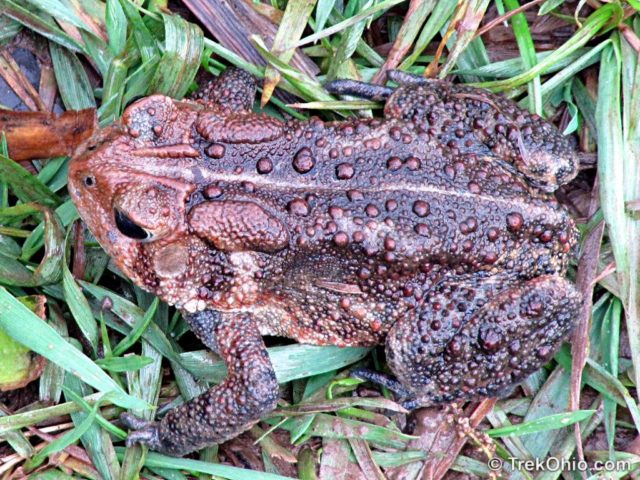
External websites describing the American toad: ODNR | OhioAmphibians.com | Wikipedia
Video of American Toad vocalizing: YouTube
Fowler’s Toad (Anaxyrus fowleri)
The Fowler’s toad may be brown, tan, gray, or light green. Although the Fowler’s toad and the eastern American toad can be hard to tell apart, one way to distinguish them is to look at their “warts.” An American toad will generally have only one or two “warts” per dark spots on its back, while a Fowler’s toad will have three or more “warts” per dark spot. In addition the bumps on the leg of the American Toad tend to be more pronounced than those of the Fowler’s toad.
Note that the scientific name has been changed from Bufo fowleri to Anaxyrus fowleri.
External websites describing Fowler’s Toad: ODNR | OhioAmphibians.com | Wikipedia
The Spadefoot Toads
Eastern Spadefoot (Scaphiopus holbrookii)
The Eastern spadefoot is called that because there is a dark, hard bulge on each of its hind feet that serves as a kind of spade or shovel. The animal uses the spades to burrow backwards into sand or soft soil. The Virginia Herpetological Society has included a nice photo of the foot in their article on The Natural History of the Eastern Spadefoot.
There are two yellow lines on the eastern spadefoot’s back. It is the only frog/toad on this page whose pupils are vertical.
In Ohio this toad primarily lives in our extreme southeast region. ODNR’s distribution maps seems to show it residing in the following counties: Lawrence, Meigs, Washington, Athens, and Morgan. However in their written description of the range for this species, they also mention the counties of Coshocton and Tuscarawas.
External websites describing Fowler’s Toad: ODNR | OhioAmphibians.com | Wikipedia
Frogs
The “True” Frogs
American Bullfrog (Rana catesbeiana)
The American bullfrog’s back may be green or brown.
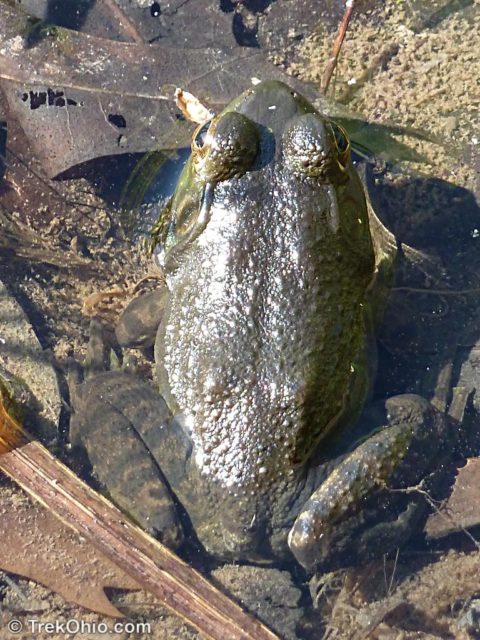
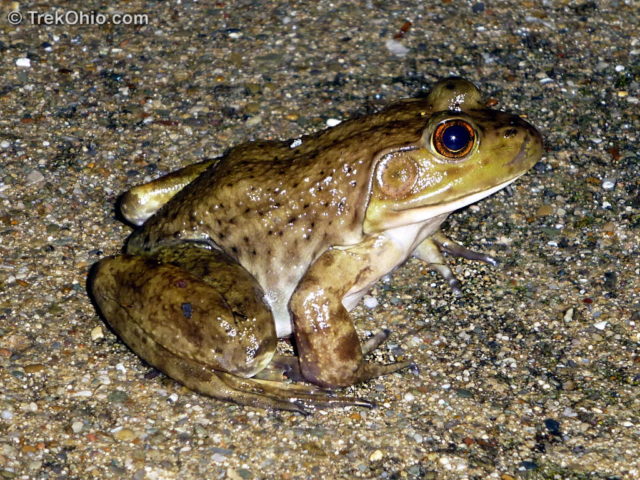
External websites describing the bullfrog: ODNR | OhioAmphibians.com | Wikipedia
Northern Green Frog (Rana clamitans melanota)
The back of the Northern Green Frog may be green or brownish green. It may or may not have noticeable spots. When it doesn’t seem to have spots, you can still distinguish it from the American Bullfrog because the Northern Green Frog has a ridge going down each side of its back, while the American Bullfrog does not.
The adult northern green frog is between 2.25 and 3.5 inches long. It is found in shallow fresh water. When it croaks, it sounds like a loose banjo string. On average they live between four and fifteen years.
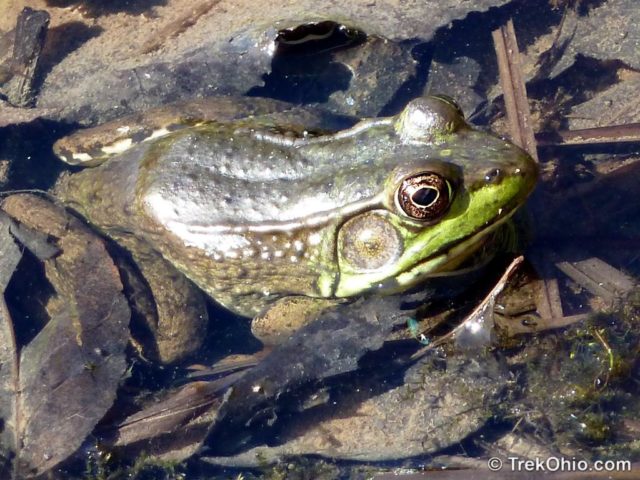
External websites describing the green frog: ODNR | OhioAmphibians.com | Wikipedia
Pickerel Frog (Rana palustris)
The Pickerel frog may be tan, light brown, or olive-green. Note that the spots between the folds on the frog’s back have a squarish quality. A couple of photos follow showing variations in color.
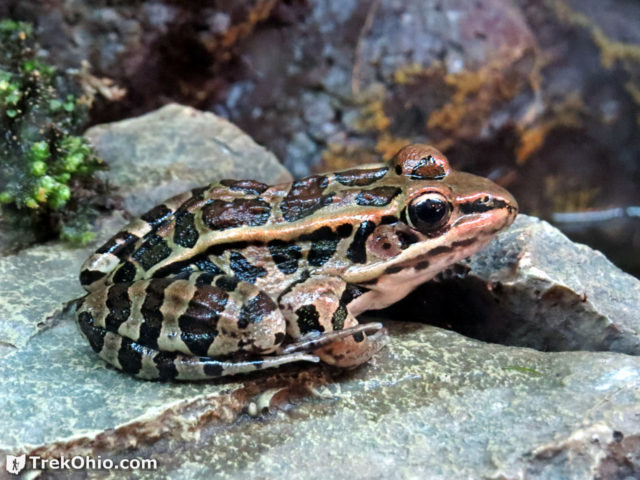
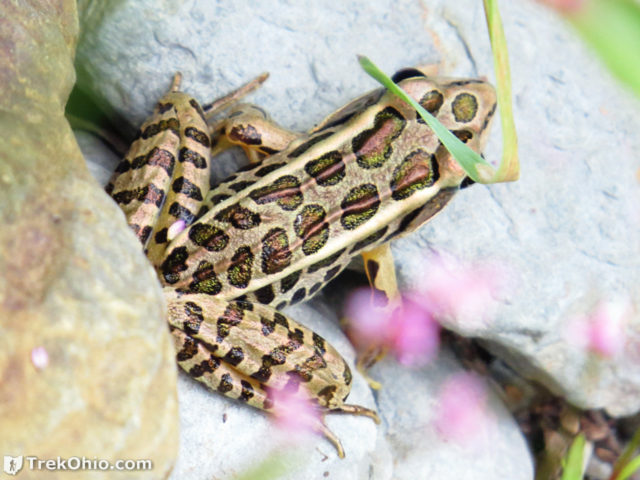
External websites describing the Pickerel frog: ODNR | OhioAmphibians.com | Wikipedia
Northern Leopard Frog (Rana pipiens pipiens)
The northern leopard frog may be tan, light brown, or olive-green. Note that the spots have a light-colored border. In comparison with the spots on the back of the Pickerel frog, those on the northern leopard frog are more narrow and more randomly placed across the back, while those on the Pickerel frog are more squarish and are lined up in two rows.
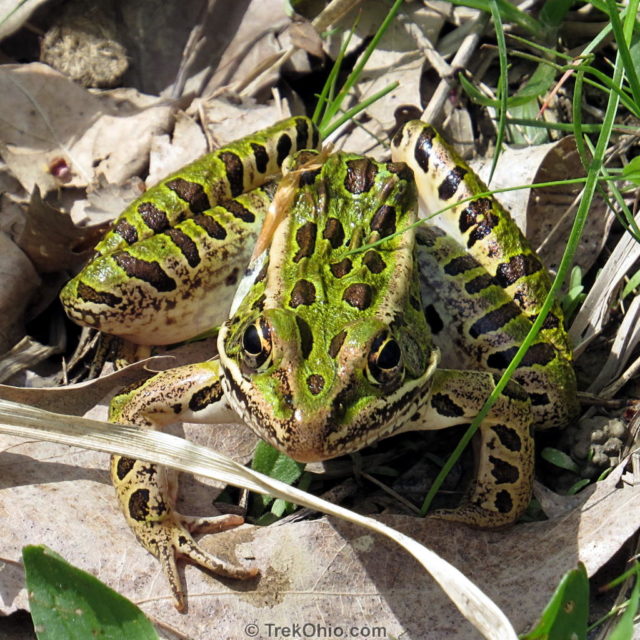
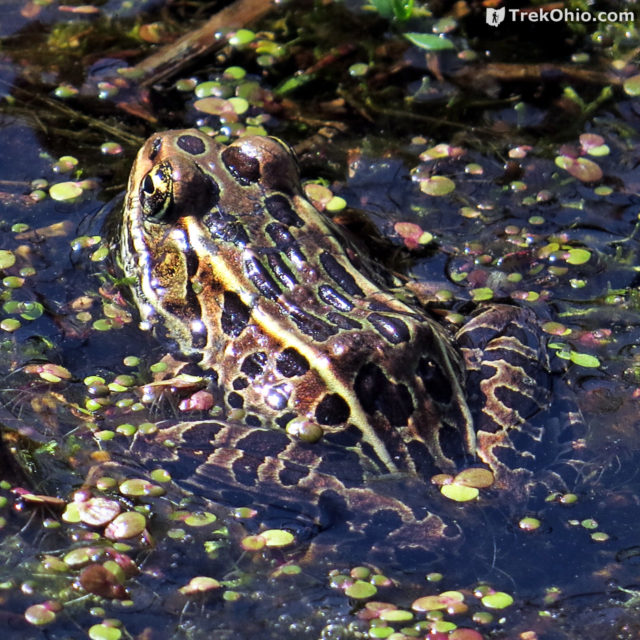
External websites describing the northern leopard frog: ODNR | OhioAmphibians.com | Wikipedia
Southern Leopard Frog (Rana sphenocephala utricularius)
The Southern Leopard Frog may be green or brown. Unlike the Northern Leopard Frog, the spots of the Southern Leopard Frog don’t have a light border.
External websites describing the southern leopard frog: ODNR | OhioAmphibians.com | Wikipedia
Wood Frog (Rana sylvatica)
Wood frogs are typically dark brown or tan, but occasionally individuals have been discovered that are a reddish color, orange or even pink.
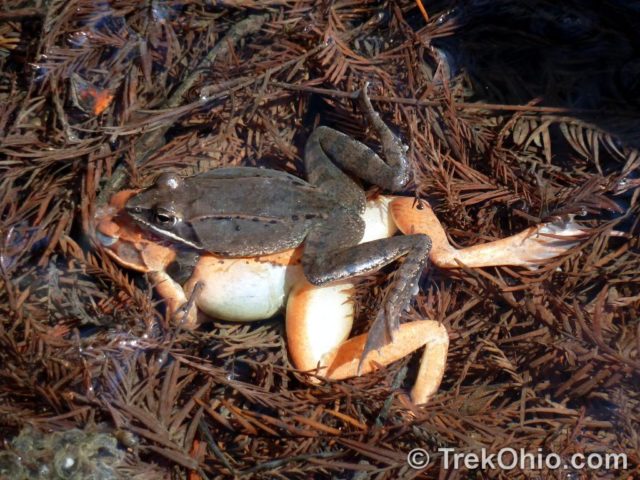
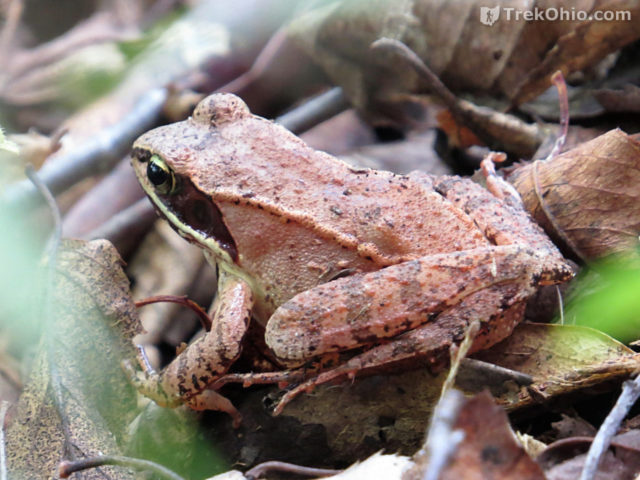
Ohio Division of Wildlife video on a Spring Chorus of Wood Frogs
External websites describing the wood frog: ODNR | OhioAmphibians.com | Wikipedia
The Tree Frogs
Northern Spring Peeper (Pseudacris crucifer crucifer)
The back of the Northern Spring Peeper is some combination of yellow, brown, tan, reddish, or olive-green.
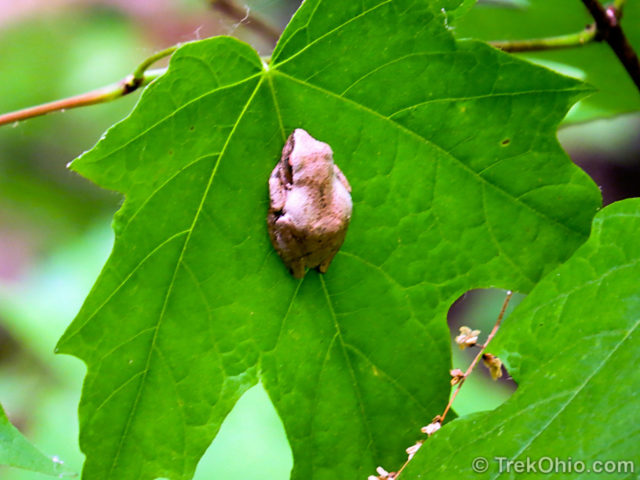
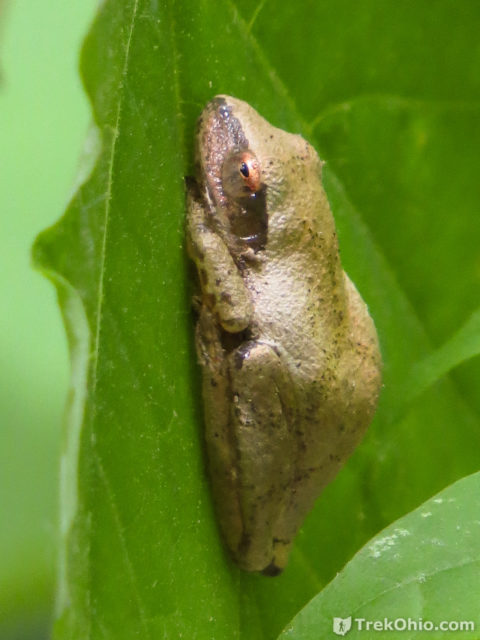
External websites describing the Northern Spring Peeper: ODNR | OhioAmphibians.com | Wikipedia (includes other varieties of spring peepers)
Blanchard’s Cricket Frog (Acris crepitans blanchardi)
It is also known as the Eastern Cricket Frog. This frog may be brown, gray or olive-green.
External websites describing Fowler’s Toad: ODNR | OhioAmphibians.com | Wikipedia
Gray Tree Frogs
Cope’s gray tree frogs (Hyla chrysoscelis)
The Cope’s gray tree frog (above) and the Eastern gray tree frog (below) are supposed to look virtually identical, but they are very different genetically. You might be saying to yourself, “Hey, they don’t look so very identical to me.” But as mentioned at the top of this post, this is part of the normal variability in color that occurs in many of these species. Typically these two species are gray, but they can change to green.
However Cope’s gray tree frog is only found in the southern third of Ohio while the Eastern gray tree frog is widely distributed throughout the state, so if you spot a gray tree frog in the northern reaches of Ohio, it is reasonable to assume that it is an Eastern gray tree frog.
External websites describing Fowler’s Toad: ODNR | OhioAmphibians.com | Wikipedia
Eastern Gray Tree frog (Hyla versicolor)
Ohio Division of Wildlife video on The Call of the Gray Treefrog (Hyla versicolor)
External websites describing Fowler’s Toad: ODNR | OhioAmphibians.com | Wikipedia
Chorus Frogs
Mountain Chorus Frog (Pseudacris brachyphona)
The Mountain Chorus Frog may be light brown or olive-green.
External websites describing the Mountain Chorus Frog: ODNR | OhioAmphibians.com | Wikipedia
Western Chorus Frog (Pseudacris triseriata triseriata)
The Western Chorus Frog’s back is brown, gray, tan or olive-green.
Ohio Division of Wildlife video on the Western Chorus Frog
External websites describing the Western Chorus Frog: ODNR | OhioAmphibians.com | Wikipedia
Additional information
- PA Herps: Frogs & Toads Of Pennsylvania
- Marshall Herpetology Lab: Frogs and Toads of West Virginia
- Daviess County Audubon Society: Frogs of Kentucky
- Indiana DNR: Frogs and Toads Of Indiana
- Michigan DNR: Michigan's Frogs & Toads
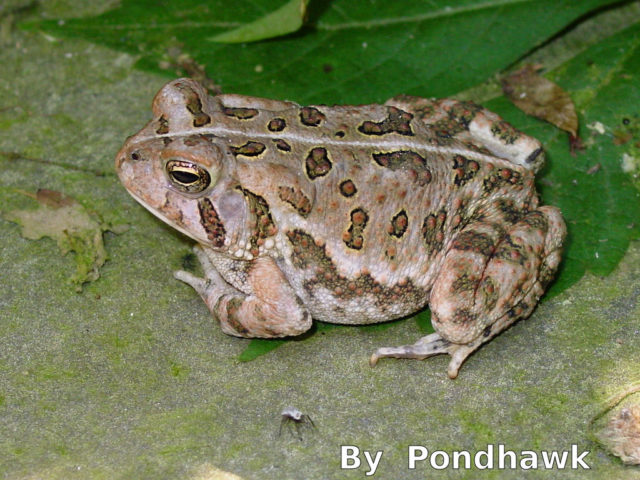
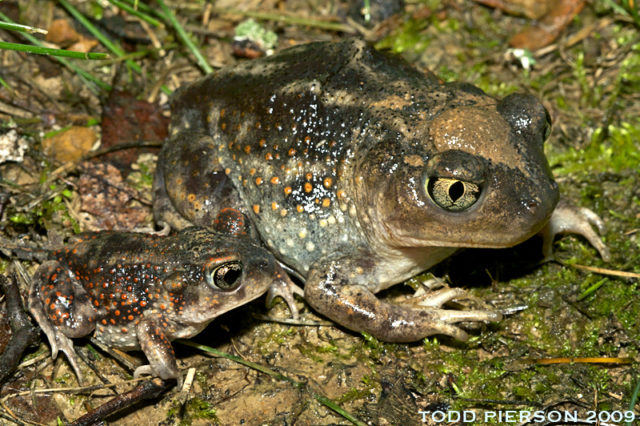
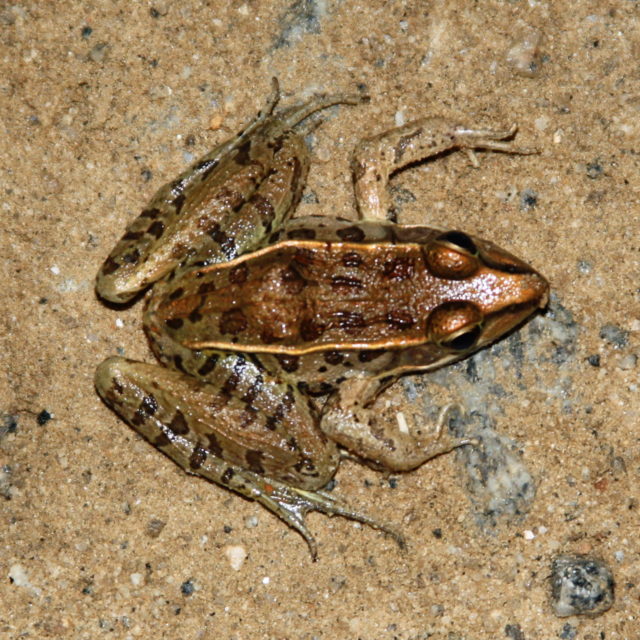
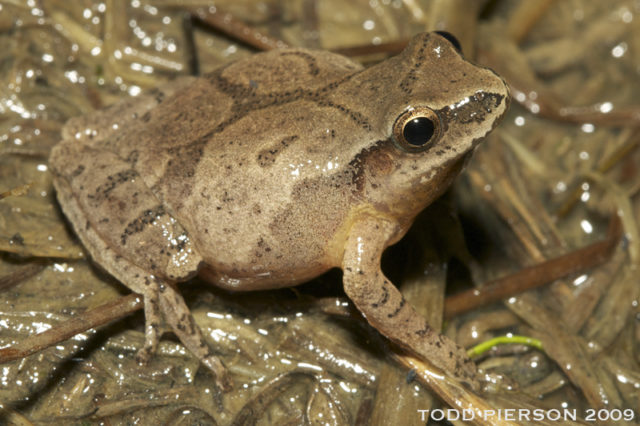
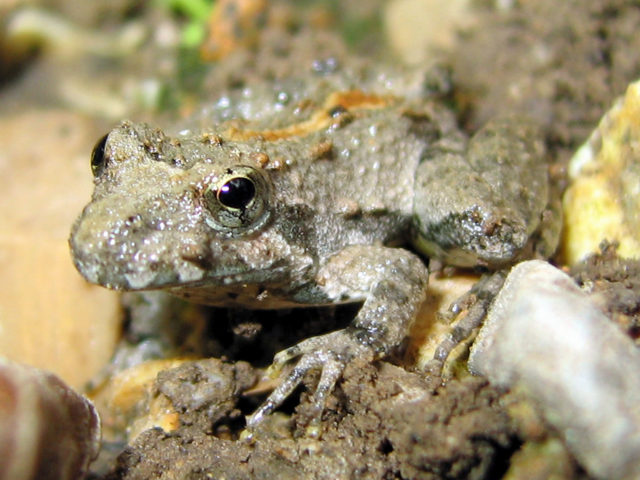
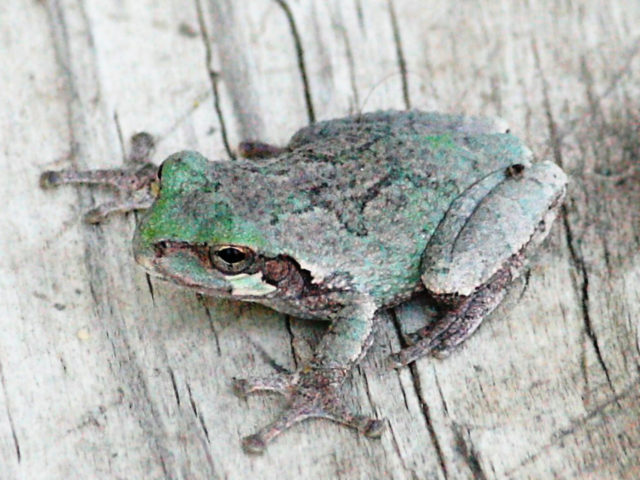
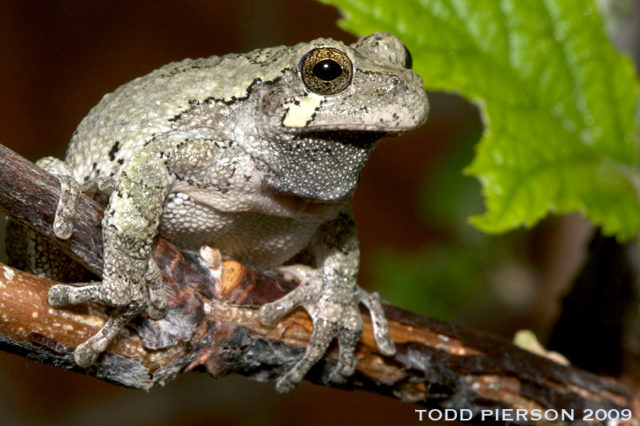
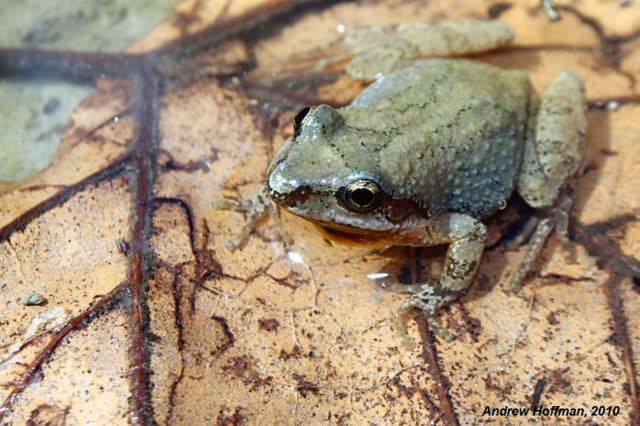
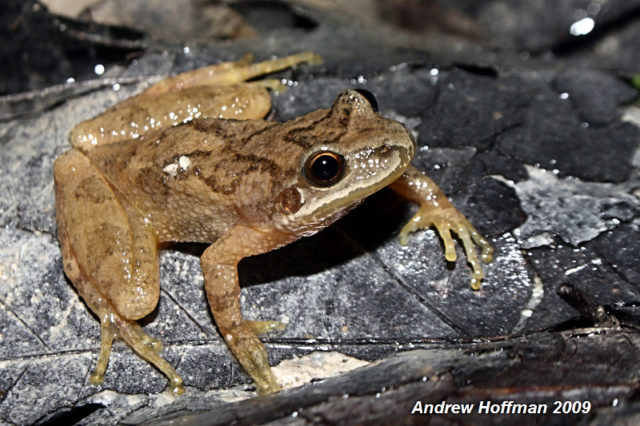
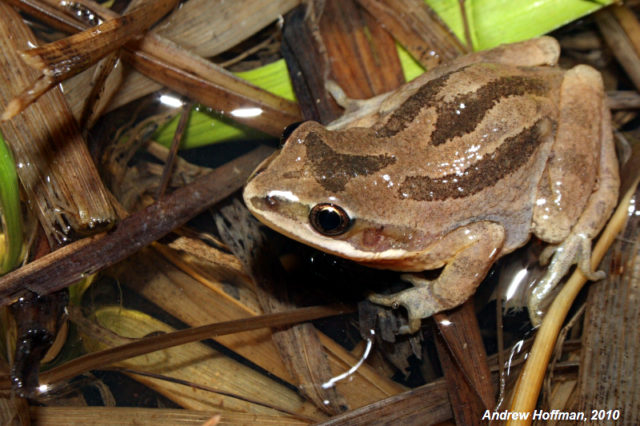
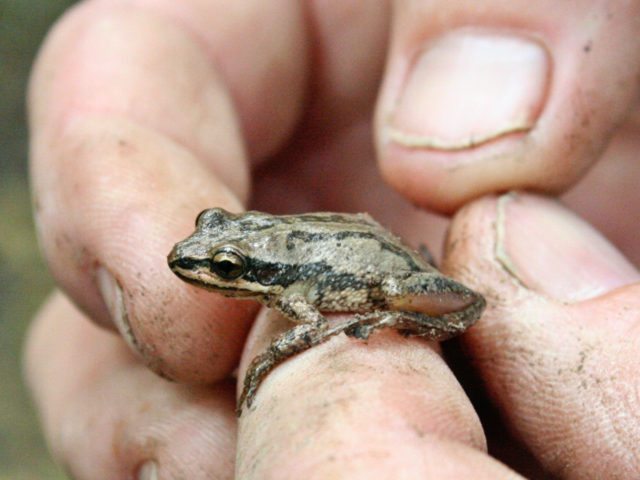
I’m quite certain I photographed a Cope’s gray tree frog in Akron. I see that they are not normally in northern Ohio though. Can I email it to you to identify?
I’m just curious I live in Clermont County Ohio. Every time it rains I see these little frogs or toads hoping over the road. We do live very close to the Ohio River but these road hoppers are much smaller than the ones I’ve encountered on the river bank.
Hello Deb, my son and I we’re out foraging for wild mushrooms. We came across a large bullfrog size specimen while digging through the leaf litter. This frog had a very gold color. It had an x on its back like a Spring peeper. While my son and I tried to chase this frog and catch it it took a single leap up into a tree about 14 feet off the ground and then proceeded to run at full speed up the tree. I failed to mention that it had an elongated neck. If you where to grab it by the body the neck is long enough to make you think he could come around and bite. I am very familiar with things that are common to Ohio. I’ve never seen anything like this. Several years later my sister came across one while installing a garden in a wooded piece of land. She had the same response as us simply startled at the appearance of this frog.
I have read soooo many comments of frogs with a blue color in ohio. I myself seen one when I was a child. Obviously we so have blue frogs here now. Maybe it’s time for an update to the list of Ohio frogs…?
A few weeks ago my husband told me he discovered a frog in our toilet. He tried to catch it but it ducked into one of the holes. This morning I encountered it. I also tried to catch it but it was too fast for me. Fortunately it managed to jump out of the bowl and into a nearby bucket which I quickly took outside. It was green and about an inch and-a-half long. In the bucket it drew its legs in so close to its sides that they seemed to disappear. We’re sure its a tree frog because it was able to climb up the side of the bucket with the suction cups on its feet. My husband was able to catch it again (after it jumped out) and he took it to a nearby creek. Our guess is that it came into house by way of the sewer line and figure it must have fallen through the hole in one of the access/man hole covers in the street and have no idea how many times it made the trip through the toilet to reach the bowl. Crazy!
I live in Trumbull County. I have two decorative ponds in the garden and one of the ca. 13 green frogs spending the summer there has a bright blue head. We had a similar one years ago, but he sadly was eaten by a garter snake. Judging from the few mentions if these “blue” green frogs and the total lack of photos of one, they must be rare.
As a child in the 50’s, I loved frogs, and roamed the countryside around Urbana, Ohio to observe them. One of my favorite locations was a creek that ran along the edge of a soybean field. One day, I saw a frog that looked just like a leopard frog, but was multicolored in green, brown, bright yellow, red, and blue. I excitedly ran home to tell my Dad, a high school science teacher. My dad told me the frog was probably a mutation. After all these years,I often wonder about this frog!
We live out in the country in Columbiana county. Well last Sunday one of our barn cats stated seizing and foaming at the mouth, then died very quickly. We could not figure out what had happened. Yesterday doing some yard work I came across a half eaten toad, could this be what killed this poor cat? If so I did not think we had poisonous toads here in Ohio.
According to this article there are two Ohio toads; the Fowler’s toad and the American toad that can kill a medium size dog (and presumably a cat) if eaten.
Teri Chapman – I have several 3-9 pound dogs. Three of them have met the toads in our yard/pond and decided to try and catch them. Luckily I have been with them and could rush them to a hose or sink. Their mouths were foaming and they were shaking their heads. I wet my hand and dug out as much foam I could and rinsed my hand often. They are fine. It is the mucus on their skin that is poisonous, I believe. I didn’t know this either. So now we both know
We live in Kent, OH and we have a blue bullfrog living in our pond! It’s beautiful! Most people speculate right off the bat that it’s blue bc we treated our pond with blue dye last summer. The only time it’s ever been treated with dye. However, I researched blue bull frogs and they’ve been found in nature preserves as well and there no blue dye there! We have great photos of it.
Okay I couldn’t find this frog listed. I found a white…blue…green frog in my yard. We live in barberton oh. I was trying to find out what kind of frog it is. Can anyone tell me. I have a pic of it.
I have seen twenty frogs with the blue to violet feet and hands in Middletown ohio today…they do not look like any of the 15 images they also have blue specks in their throat balloons…they are almost tame. They are abundant in a natural metro park here.
Any thoughts on what it is? I will try to post pics tomorrow
I live in Loveland Ohio do you have pics? Where are they located? Email kd8fki@gmail.com
Hello, I just found a frog/toad on my table inside the house. I believe it has been living in my houseplants that I brought inside this past September. Would it be better to put it outside on a warmer winter day or keep it in a terrarium until spring? Any advice would be appreciated.
I think it would be better to wait till it is warmer. Many species of frog prepare for winter by digging into the ground and burying themselves. However, at this time of the year the ground is frozen, so I don’t think they’d be able to pull it off.
I have a little frog living in my hanging fern planter, it has container of water hanging under the planter to keep water in. He sometimes moves from there to my porch light and back. My question is what will I do with him when it’s time to take the planter down and will he be ok? Where will he go during the winter?
Frogs and Toads hibernate over the winter, but the manner in which he chooses to hibernate depends on his species. Some species hibernate at the bottom of ponds. Toads and some frogs are very good diggers, and they hibernate by digging down till they are past the frost line where they remain through winter. And there are other frogs, like the Cope’s Gray Tree Frog that aren’t capable of digging down that deep, but still spend the winter on land. What they do is bury themselves under leaf litter or mulch, or squeeze into some little cranny. Since they are not below the frost line, they do partially freeze, but amazingly they thaw out and resume life in the spring. They have a sort of biological anti-freeze that keeps them from freezing entirely.
I have a frog living in my bedroom windowsill in my basement. I think he’s a northern leopard frog but I’m not 100% sure. He got in around last summer or spring and my sister and I named him Todd. I don’t know how he got in because we have a cover on the windowsill. Also I don’t know how he’s lived this long without dying but I think he’s eating spiders and there’s always a little bit of water in the bottom of the sill. We haven’t been able to get him out yet because he has this little hole in the corner he crawls into that we can’t reach into. Any ideas on how to get him out?
Mo, wow, that’s a tough one. If you happened to see Todd while he’s farther away from the hole, maybe you could drop something over the hole before you tried to catch him. Still it’s good to hear that he’s survived so long.
Can you identify this frog. He has been at our back door every day looking for bugs I suppose. We have two ponds in front of our condo so I am guessing frogs originate from there. Every year we have one frog like this one in the same spot? We have small dogs that look at him but do not get too close nor do they bother with him much. I am worried a little that if they choose to get closer they may get smeared with the glands this frog may have on his neck?
Steve, if you have a photo of the frog, you can send it to our gmail address (username: trekohioblog).
I’m new to the central Ohio area (2+ years). I grew up in eastern PA and the Pocono mtns were my home away from home. I’m pretty familiar with all the fauna in that area, including amphibians, but sadly, I didn’t experience the NUMBERS of tiny little toads and tree frogs until this year, in our country yard. For nearly 2 months, our little 1 acre property was over-run with dime sized toads. Every. Single. Step. Even accidentally squished one between my toes. =( Can’t wear sandals out there since then.
Been getting some adorable tree frogs on our kitchen window. I believe they are chorus frogs. My father in law finds frogs and toads in his yard constantly. This past week he found one nestled on his garage door. Tiny. About 2 inches? Bright green back and back of head. Bright green on tops of back legs. Black and white speckled along sides and on face. White belly and undersides. I have a photo, but not sure how to share that on here. Is there another way to share that photo for you to identify? Could it be another species that nobody, till now, has discovered?
Dawn, you can attach a photo of your frog to an email and send it to us. We have a gmail account. The username associated with the account is trekohioblog.
I have a 75 gallon rain barrel with a downpour directly flowing into the barrel. There is a screen on top so debris won’t get washed in. Tonight as I checked the barrel, floating on top of the water inside the barrel was a tiny toad about the size of a quarter. I rescued the toad , it was still alive, and let it find it’s way on the ground. But my question: any ideas on how it got inside the rain barrel. There is no spigot…just a hose that is clamped at the top. Could the toad entered in the overflow tube on the ground that was full if water but that would put the toad entering at the bottom of the barrel. I was shocked
Sorry for the delay in getting back to you, Sheryl. We were on vacation. As to your question, I am as mystified as you were as to how the little toad managed to get into your sealed rain barrel. Anyway, what a stroke of luck for it that you happened across it and were able to save it.
I have grown up in Northwest Ohioand have lived here my entire 29 years and have recently noticed an explosion of gray tree frogs on our property I was wondering if there is a scientific explanation as to why I see so many on our property as a child I had never seen so many at once we have recently put in flower beds around our shop and I keep seeing them shortly after it rains by the dozen I do have to say that it is quite awesome however I am still perplexed at this strange occurrence. has there been a population increase in that species
Matt, I wasn’t aware that there was a population explosion of gray tree frogs in NW Ohio, and I am at a loss to explain it. However I’ve always heard that amphibians are more sensitive to environmental pollution, so maybe their increase in number is a good sign.
We recently found 8 tiny baby toads color ranging from light green dark green and even a rusty brown, in our basement window well, we have a pond behind our house about 600 yards on the other side of some railroad tracks, so we brought all of them to that location. For the last week we keep having 4-6 of the same type, size and color of toads back in the basement window well. I want to know if they are returning? What’s the habit or nature of theses creatures?
Erin, someone else just wrote in to report they have also been finding toads in their basement window wells. I don’t know if they getting accidentally trapped. Since multiple people have described this occurrence, I am trying to contact a herpetologist for an answer.
I have a deep window well and have seen a toad in it for about 2 weeks. Now I am seeing 4 little ones in there. My question is can they climb in and out. It is about 3 feet deep. I noticed they kinda bury themselfs under the pebbles when it is hot out.
Julia, I don’t honestly know the answer to this one. However, I note that I just received another comment from someone describing toads living in their window well, too, so it’s not just happening at your home. If you are worried that they can’t get out, you could try sticking a board diagonally in the window well. I was once at a camp site and discovered a raccoon trapped in a nearly empty dumpster. I stuck a branch into the dumpster that stretched from the bottom to beyond the outer rim. When I checked back a few hours later he was gone, so I think he used it to escape.
Recently I’ve been hearing the sound of a tree frog in my house! Doesn’t seem to always be in the same area. Best way to locate it? No clue how it gained access to the inside.
Thanks for answering.
Mavis, I wish I could give you some advice, buy I’ve never heard of a tree frog getting indoors before. Any chance the sound might be coming from a cricket?
could he have come up through a sump pump? Mice and spiders come out of where we have ours, maybe a frog climbed out
We currently have two that live in our kitchen. They usually stay in our potted plants by the a window that has a light that shines constantly where they can easily catch insects. One has been here for at least two years. He hibernates in our potted bamboo plants during the winter , but returrn to the potted plants during the warmer times. The other, we believe was brought in by the cat and escaped. Our cat has caught other frogs as well, bringing them inside without harming them and releases them for us to catch and release outside again, but we mistook this for our froggy friend in the window, and so we put him in with the potted plants. That’s how we discovered that we now have two. One is jade green and the other is like a little froggy soldier in khaki camo. They both sing, showing that they are both males. They show little fear of us and often watch us as we come and go. They seem quite content with their lives in our kitchen, and we are happy to share our home with them.
Your frogs are the first flower-pot frogs that I’ve heard of. I’m glad they seem to have made such a good adjustment to their new home. I wonder what your cat thinks of them.
My friends kid keeps bringing toads home and not taking care of them. They die and he finds more. I was going to take the newest ones outside and set them free. We live in the Grove city area but he got them from hocking hills area. Where is a safe place to take them? Should they go near water or in a wooden area?
For more then several years now I have had little frogs/toads that I find in my flower beds or on the sidewalks around them and i just love them, 2 questions….,1. Is there a benefit to having them around besides to eat bugs and 2. Can you buy frogs and release them around your flower beds and/or gardens or would they not know how to defend themselves?
Yes, there are plenty of benefits having them around, and I’m sure you could buy these at a store and release them but I advise against it because if bought towards an older age they will not be suited for a wild habitat. If you proceed and do buy them DO NOT buy frogs, toads are the ones that are around your sidewalks and garden they prefer dry habitat while a frog wants very wet habitat with a pond.
I’m responding to the lizard comment above. I have researched, kept, written about and photographed the local European Wall Lizards for many years. The local European Wall Lizard species Podarcis muralis does not have green on the top of its body. The species of wall lizard that does is Podarcis siculus and they do not live in the Cincinnati area. The two species are similar and both came from Italy. In the U.S., the Podarcis siculus wall lizard lives in southern California and New York city but are spreading. An article I wrote about the 3 European lizard species living in the United States can be seen here http://cavemanetris.hubpages.com/hub/Lizards-from-Italy-Living-in-the-USA. Photos are included in the article.
I’ve never seen such a small frog before:
While walking my dog at Frohring Meadows park in western Geauga County, he went off into the meadow, where plants are nearly 4-feet high, and came out a few minutes later.
He had a bright green spot on his head that I thought was a leaf but was a bright green frog — solid green, as bright as the leaf in the above photo over the head of the Blanchard’s Cricket frog.
It leaped off his head as I was reaching to brush it off.
It was not bigger than my thumbnail, and I’ve never seen such a small amphibious critter before.
The park has numerous ponds and wet sites, and I hear spring peepers and tree frogs all the time.
Any idea what that little frog could’ve been?
All of the frogs in the “tree frog” category are very, very small. Given the green color that you described, I am guessing that it was either an Eastern Gray Treefrog or a Cope’s gray tree frogs. Despite the word, gray, in the name both of these can be green.
Although I don’t have a photo showing the scale on these two tree frogs, I do have one of a Northern Spring Creeper. He’s clinging to the surface of a maple leaf, so the leaf itself provides some scale showing how tiny he is. The gray tree frogs are also tiny like this. Click on the image to see a larger version of the photo.
Need to ID a frog with a blue head, and the rest of him is bright green. He loves our swimming pool. We have grandkids coming to visit us soon, and wonder if he could be dangerous.
Sorry, I can’t help you out with this one. I don’t know of any frogs in Ohio that have blue heads. On the bright side, there are no toxic frogs in Ohio. However all toads can emit a toxin from glands right behind their eyes, but they do this when an animal has seized them to provoke the animal into spitting them back out.
I am in central Ohio and I found a small frog that is just green and has small warts all on its back. The stomach is white. Any ideas on what this could be?
If it is warty, it is probably a toad. One way that you can confirm it’s a toad is to look for swellings on each side of the head behind the eyes. These swellings are called parotid glands. If an animal snatches up a toad with its mouth, the toad will emit toxins from these glands that may prompt the animal to spit it back out.
We only have two species of toads in Ohio. Every single toad that I’ve seen while living in central Ohio has been an Eastern American toad, so I am assuming that they are much more common than the other species, the Fowler’s toad.
The great tree frogs have wart skin as well and do turn green or brown based upon what it is testing upon
My grandmother lives in southern ohio and found a frog in her bathroom. She says it was bright lime green and had a stripe on it’s back. Possibly running diagonal. She may be confused on some of the details but any ideas on what type of frog it might have been?
My puppy was just found chewing on one of these amphibians. Are any in NE Ohio known to be toxic?
Ryan, all toads excrete an alkaloid poison (bufotoxin) from the glands behind their eyes when they are afraid. I don’t personally know whether the bufotoxin excreted by Ohio toads pose a danger to dogs; however, I did do a web search when I read your question. According to Dr. Bari Spielman at petplace.com, the two species of toad in the United States that pose the greatest danger to dogs are the Colorado River toad (found in the southwestern U.S.) and the Marine toad (also known as the Cane toad; found in southern Florida and Texas). Neither of these species are found in Ohio.
According to Dr. Spielman, here are the symptoms exhibited by dogs that have been poisoned by toads:
Since it’s been over 12 hours since you posted your question, I hope your dog is doing okay.
I found a small frog with a green back and brownish tan belly. Could it be a western chorus frog? I live in northern madison, ohio if that’s any help.
Almost every frog and toad species shows a lot of variation in color. I am tempted to think that the frog that you saw may have been the Northern Green Frog. Did it have any ridges on its back? Is there a picture of it online anywhere that would be visible to me like Flickr? Instagram?
We just caught a released a HUGE frog in our pond. Obviously it’s so big that you assume it’s a bullfrog, but the bottom of the frog is throwing us off. it has a cool white and brown squiggly line action going on, very distinct. I’d love to e-mail someone a picture to show them this thing and just confirm it’s a bullfrog. The only other thing close that it looks like is the Northern Green Frog but it doesn’t have the ridges.
Thanks for the comments distinguishing one from the other…very helpful!
Your welcome. Perhaps you feel up to taking the quiz at the end of Amphibians at the Inniswood Pond. 😀
I FOUND A TOAD RESEMBLING THE FOWLER OR EASTERN TOAD IN MY GARAGE AMOUNG SOME WET CARDBOARD BOXES ON THE FLOOR, BUT THE TOAD I FOUND HAD A DEFINITE BLUE COLOR MIXED IN WITH THE DARK BROWN OF IT’S BACK. ANY SUGGESTION AS TO THE IDENTITY? THANKS
Ruth, I don’t believe any of the toads in our state have a blue pigment. I am wondering if the blue color was transferred onto the toad from something it was crawling through. For instance, if you put down one of those plastic grocery bags on a wet counter, the pigment from the writing on the bag will transfer from the bag to the counter. So maybe there was some blue printing on the cardboard boxes, and the toad crawled through it. Or maybe there was some mold on the boxes (mold can have a bluish cast).
If that’s not the case, I confess that you’ve totally stumped me.
we just found a frog exactly what ruth said but it was in our garden it was neon green with a bright blue streak down it back
I’m baffled by reports of frogs with blue streaks or blotches. I’ve wondered if this might be a lizard that has lost its tail (if a predator grabs the animal by the tail, the tail snaps off). There is a species of lizard that lives in the Cincinnati area that has blue markings. It’s known as a wall lizard. Jim McCormac has published a nice article about this lizard, including photos that show off its blue mark. You can see McCormac’s article here. Since its introduction to the area from Italy, the wall lizard population has grown to about a quarter million, and the lizard has spread into Indiana and Kentucky.
I don’t have a photo of one myself, but here’s one that is licensed for free use that I found on Flickr.
Wall Lizard (Podarcis muralis)
Although the lizard in the above photo has a distinctly green back, the color varies. The photos of the one in the McCormac article show a wall lizard that isn’t green at all.